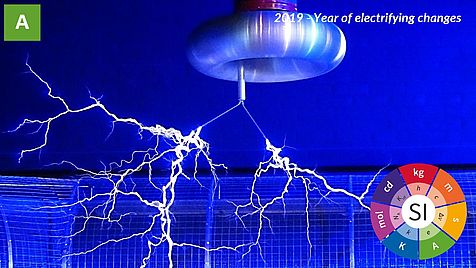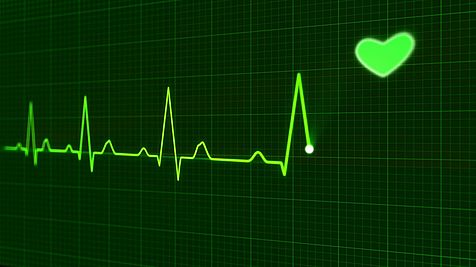Please type a search term (at least two characters)
Unit of the month January 2019: Ampere

Electric current, for most of us, seems to appear mysteriously from electrical sockets and gives life to our appliances. Just like the blood in our veins, an electric current is flowing through the "conductive arteries" in our homes, powering the everyday equipment we need. That's why we consider our unit for the month of January to be a bit of a hero. In fact, in 2019, the ampere - the SI base unit of electric current - will be undergoing some "electrifying" changes.
Today, electricity is so common that a most of us rarely give it a second thought. But, if it suddenly disappeared, life would quickly become very hard indeed. Lights, television, radio, phones and computers, the washing machine, dishwasher, fridge - a seemingly limitless list of appliances, operating only when electric current is present, which would no longer be available to us. Try and think about how many times you've made use of electricity already today. It was probably at least three before breakfast!
The earliest historical work on electricity comes from the ancient Greeks, who described static electricity. They observed that when amber was rubbed with a piece of fur it began to attract small objects such as hair or dust. In fact, the word electricity comes from the Greek electron - ηλεκτρον - meaning amber. After the phenomenon was first noted on, however, "Amber electric current" went unstudied for many years, remaining only a strange curiosity. Further development on electricity began again in the 17th century, but it was only in the 19th century that work in this field started in earnest.
The rapid developments in electricity seen during that time also brought advancements in metrology. Not only was the measurement of electrical quantities easy to implement, but electricity was extraordinarily useful for all kinds of scientific activities - yielding new research, technology and industries. As a result, electrical measurements quickly dominated every field of metrology.
To this day, most quantities are measured by electrical methods - even non-electrical ones like mechanical properties.
With ever-increasing knowledge and understanding of electrical science it was also possible to measure our hero - ampere - with growing accuracy and precision. The first definition of the ampere was introduced during the International Electrical Congress held in Chicago in 1893, and confirmed by the International Conference in London in 1908. This "international ampere" was an early realisation of the ampere we now know; defined as the current that would deposit 1,118 milligrams of silver per second from a silver nitrate solution. Measurements have now revealed that 1 international ampere is today's 0,99985 A.
However, this definition had a major disadvantage: It strongly linked the unit with its practical realisation, meaning it was difficult to have certainty that measurements made in different times and places were exactly the same. Eventually, after constant development in generating and measuring electric currents, it became clear that there were much better methods to realise the ampere. For this reason, the 9th General Conference of Weights and Measures (CGPM) in 1948 approved a new definition of ampere, which is still valid today:
The ampere is that constant current which, if maintained in two straight parallel conductors of infinite length, of negligible circular cross-section, and placed 1 metre apart in vacuum, would produce between these conductors a force equal to 2 x 10–7 newton per metre of length.
With this definition advancement in measurement science accelerated again. Having an accurate and precise way to define the ampere meant metrologists were able to examine different physical phenomena that could be used in construction of more and more accurate measuring instruments. Quantum physics, for example, has been especially fruitful in providing new and innovative solutions for measurement challenges.
Now, however, practically realising the SI base unit - ampere - is far from the official definition. Present practical realisation of the ampere is based on the relation of electric current with voltage and resistance. A device called a 'Josephson junction' is used to generate the voltage, and the 'quantum Hall effect' generates resistance.
Both methods use physical phenomena that are well understood, and are dependent on physical constants: the Josephson constant and von Klitzing constant respectively (both Josephson and von Klitzing are Nobel prize laureates), that can both be expressed in terms of fundamental constants of nature: e - elementary charge and h - Planck constant.
What advantage is there in using these constants? Natural constants remain unchanged no matter what, so that using them to define a unit makes that unit measurable throughout whole universe (e.g. Planck constant is just the same in Copenhagen, Rome or on Mars). Units that are dependent on constants of nature also assure the long-term stability of measurement standards.
The ampere definition from 20 May 2019 will be: The ampere, symbol A, is the SI unit of electric current. It is defined by taking the fixed numerical value of the elementary charge e to be 1,602 176 634×10-19 when expressed in the unit C, which is equal to A s, where the second is defined in terms of ∆νCs
The change in definition is radical, and will be a milestone in the field of measurement science. The redefinition will be ready to underpin the challenges of science and technology of the 21st century.

Did you know... Each of us is a small power station. Our nervous system is an "electric circuit" that constantly sends millions of visual, tactile and auditory stimuli in the form of electrical impulses to our "central unit" - the brain. The brain then processes these electrical impulses so that we can see, hear, taste, smell and sense heat, cold and pain. In return, the brain, transmits appropriate electrical impulses back to our body to control it. Thanks to electrical impulses our heart beats! We can consciously walk, run, paint, and jump. Whether we like it or not, our January hero - the ampere - is always within us!
The fact that each of us is "charged with current" can be particularly useful in medicine, and especially in diagnosing diseases or administering lifesaving treatments. When our heart stops, for example, we use a defibrillator - a piece of equipment that delivers a dose of electric current to the heart. In heart diagnostics we commonly use electrocardiograph (ECG), which is no more than a very sensitive current measuring instrument. ECG records, analysed by specialists in cardiology, are a powerful tool that can reveal a lot about the condition of a heart.
